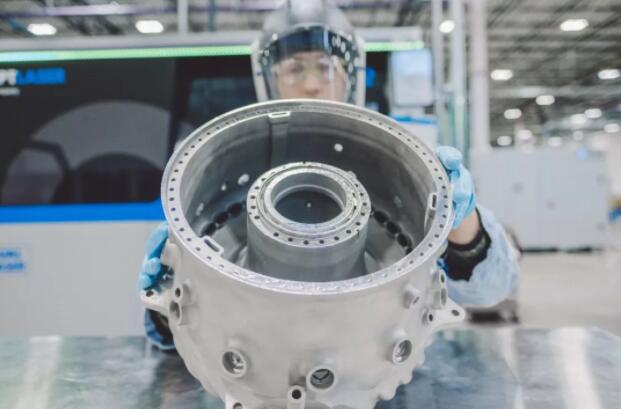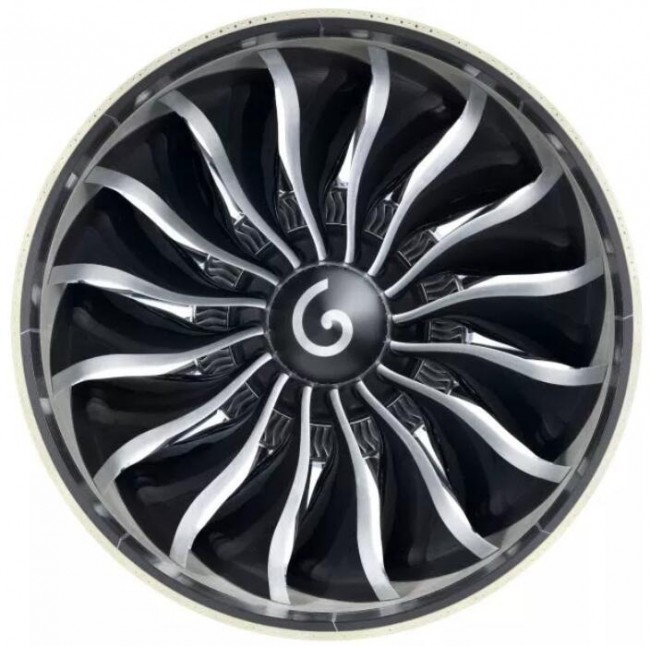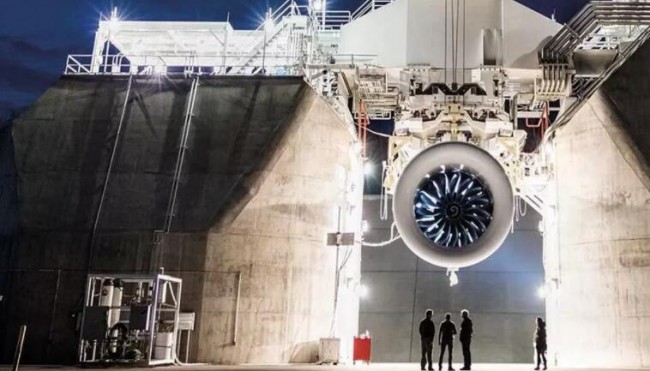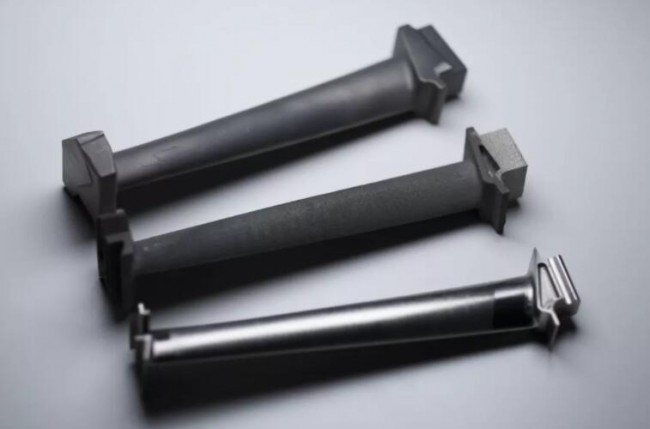GE is in a transition period (transmission). The most important thing is that (the real big bang) is not to reproduce the same parts as the original, but to produce completely different parts, different shapes, different materials, and different performances. , GE is breaking through the limitations of traditional manufacturing thinking. Don’t think about the original frame. This is related to the new method and new vision of liberating product design.
Picture: GE passed3D printingAchieve manufacturing transformation
![]() Next-generation aircraft engine
Next-generation aircraft engine
GE9X is the power engine of Boeing 777X, the world’s largest commercial aviation engine, the engine can provide about 100,000 pounds of thrust.The engine also has a new generation of 11-stage high-pressure compressor with a pressure ratio of 27:1, a third-generation TAPS III combustor with high efficiency and low emissions, and a ceramic matrix composite (CMC) combustor and turbine.
The GE9X engine, which adopts brand-new materials, new manufacturing technology, cooling technology, and aerodynamic design, is the only engine selected for Boeing 777X series aircraft. GE9X is a masterpiece of GM’s innovative research and development. Its 60:1 supercharge ratio is a gas turbine. The most in the history of aero engines.
GE9X has 304 parts manufactured through additive manufacturing, covering seven types of3D printingParts.Digitization, new materials,3D printingThe innovation of aero engines is being promoted, and GE has initiated the layout of the commanding heights of next-generation aero engine technology.
7 kinds3D printingParts
Although the news about the contribution of additive manufacturing to GE9X has been widely reported, there is no official report to reveal the top 7 on GE9X.3D printingParts, they are:
-Fuel injector
-T25 sensor housing
-Heat exchanger
-Inducer
-Stage 5 Low Pressure Turbine (LPT) blades
-The sixth stage LPT blade
-Burner mixer
According to China3D printingThe network understands that the manufacturing and certification process of components on the GE9X engine suitable for additive manufacturing is complicated. However, GE is able to use the foundation of early success. These components have complex geometric shapes. Early success stories enable GE to realize a core of “copy” and inheritance of experience.The fuel nozzle of GE9X is basically the same as the fuel nozzle of LEAP engine. The fuel nozzle of LEAP engine is often considered to be the first one produced by GE Aviation through additive manufacturing.3D printingParts.However, GE is3D printingBefore its first LEAP fuel nozzles, it was first more than 400 GE90 engines3D printingThe T25 sensor housing. When the first sensor appeared on the GE90-94B jet engine in 2015, it became the first additive-manufactured aircraft engine component certified by the FAA.Based on these successful experiences, when the initial work of GE9X began around 2013, GE decided to continue3D printingThe fuel nozzle and sensor housing are not surprising.
GE9X heat exchanger and inducer are a different story. GE Aviation’s heat exchangers traditionally consist of dozens of thin metal tubes.For GE9X3D printingHeat exchangers have completely different shapes, including optimized channels and complex internal geometries, which can take full advantage of the design freedom that can be achieved with additive manufacturing.The inducer is designed to improve the durability of the engine, combined with the design freedom brought by additive manufacturing, to meet the challenging technical requirements of customer needs.3D printingThe inducer represents GE’s continuous development in the field of aeroengines. The GE9X inducer is another example of design engineers combining multiple component features into one part through additive manufacturing.
The heat exchangers and deflectors demonstrated GE Aviation’s major manufacturing transformation efforts, and the GE9X used3D printingThe low-pressure turbine blades are a leap that GE has been preparing since 2013. These blades were manufactured by a former supplier that GE acquired in Italy.
Among the seven additional parts manufactured for GE9X, except for LPT blades and heat exchangers, other types of parts are all manufactured by printing cobalt-chromium alloys on the Concept Laser M2 machine through selective metal laser melting technology. GE acquired a majority stake in Concept Laser in 2016. In the same year, it acquired Arcam AB and launched GE’s additive manufacturing business unit. In 2016, GE rebuilt the former Dell computer distribution warehouse in Cincinnati, Ohio and turned it into a large3D printingA year of facilities and development centers.GE Additive Manufacturing Technology Center (ATC)Composed of more than 300 employees, these employees come from the two business units of GE Aviation and GE Additive Manufacturing. They span the fields of materials science, mechanical engineering, design, programming and logistics.At present, ATC’s technical team is transitioning the production of GE9X parts to the Auburn plant. The current LEAP fuel nozzle3D printingAt a rate of 800 per week, this is a fully industrialized high-volume manufacturing. GE may double its fuel nozzle output this year.
At the ATC Additive Manufacturing Technology Center in Cincinnati, Concept Laser equipment is prepared and tested before being shipped to the Auburn factory and other production facilities. In addition to the equipment to be delivered, there are also equipment in production. At ATC, there are 18 The Concept Laser machine has been dedicated to producing CoCr (CoCr) alloy parts for the past few months.The road to additive manufacturing of LPT blades is full of mystery. Titanium aluminum alloy (TiAl) blades passed Avio Aero in Cameri, Italy. 3D printingFactory for manufacturing. Modern facilities include 30 large black Arcams 3D printingEach printer is equipped with a 3 kilowatt electron beam, which can be used to produce up to six 15.75 inch blades at the same time. By the end of 2019, there will be 50 Arcams 3D printingThe machine is mainly used for LPT blade production.
Compared with traditional nickel-based alloys, titanium aluminum alloys provide a very excellent strength-to-weight ratio. But this advantage comes at a price. Just as electron beam melting is a technically demanding process, TiAl is a “notorious” difficult-to-process material. Previously, GE Aviation needed to cast TiAl blades into blanks first, and then process them into final shapes through CNC machining. This process requires a long delivery time to manufacture the mold, and through the EBM process, GE can shorten the blade processing process. In addition, GE has also customized materials and explored its own processing technology to avoid residual stress by adjusting layer thickness and processing speed.
While studying the production process of commercial jet engines, you will eventually see a video clip of a dead bird shooting into a rotating fan blade. This example was tested at the GE Aviation plant in Peebles, Ohio. The certification of GE9X (and all commercial aircraft engines) was completed with the FAA and not submitted to the FAA. This is essential for FAA to accelerate the certification process and promote the rapid development of additive manufacturing.
GE9X is the first time that GE Aviation has used multiple materials in aviation applications.3D printingThe technology has been widely used on GE9X. Now GE is developing a real industrialization base and creating a series of related standards.
These standards not only help GE control the standards of multiple production bases, but also help GE control multiple raw material suppliers. In other words, these standards are to provide the basis for the true industrialization of additive manufacturing.
(Editor in charge: admin)







0 Comments for “The next generation of aircraft engines, see the surpassing of 304 3D printed parts on GE9X!”